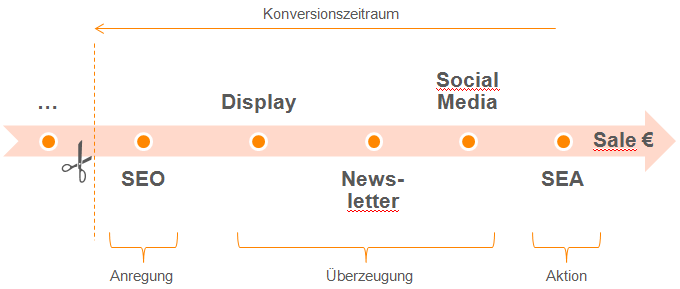Customer Journey Reports
The customer journey describes the visitor’s process up to the final decision and conversion. The stages on the journey to the destination are advertising media contacts and website visits . In the case of spontaneous or very targeted purchases, the customer journey can consist of a single contact. However, customer journeys can also extend over longer periods of time and numerous stations .
If a customer journey consists of several contacts with different advertising media or channels, the question arises as to what contribution the individual contacts have made to success and therefore which advertising media should be allocated which share of sales . This can be done using so-called attribution or distribution models, which distribute the revenue to the contact points according to certain rules or weights.
But it is also about understanding the user better so that we can then in turn
- campaigns in such a way that there is a meaningful interplay between the advertising media. So you need to know which measures not only work individually, but also in which combinations to achieve the greatest possible success.
- Design advertising media and landing pages in such a way that they appeal to visitors at the appropriate stage in the decision-making process. For this purpose, the advertising media contacts are linked to a multi-stage model of a purchase decision process. In many cases, the effectiveness of advertising media is not evenly distributed across all phases, but instead focuses on the customer journeys of all visitors.
The aim of the etracker Customer Journey Reports is to provide information on the extent to which, in which combinations and in which phases advertising measures contribute to success.
Advertising impact” report
The advertising impact report makes transparent how channels (media), campaigns and keywords work:
- predominantly stimulating customer interest (i.e. at the beginning of chains with at least two contacts)
- more likely to be persuasive (i.e. in the middle of chains with three or more contacts)
- Trigger the desired conversion at the end of a chain with at least two contacts
- Directly achieve the desired conversion without further contact (direct purchase)
The four cases outlined above result in the four key figures in the report: suggestion, persuasion, action and direct purchase.
Example:

Contact combinations” report
The Contact Combinations report under Marketing Reports → Customer Journey shows the sequence of contacts that a visitor has made, grouped according to the number of contacts. The distribution of the number of contacts according to orders or sales is shown,
- whether interactions exist or must be taken into account (if a significant proportion causes more than one contact, whereby sequences of the same media are also found in the contact chains and type-ins are also considered contacts).
- how long or complex the decision-making process is (the more contacts, the more complex the process).
By activating the contact sequence, you can view the top sequences by number. The column labels can be used to sort by orders, turnover or frequency. This allows you to see which combinations are the most successful. The report also gives an indication of whether certain media tend to occur at the beginning or end of the contact chains. To discover key areas of effectiveness within the decision phases, you do not have to laboriously derive this from the individual contact chains, but can use the Advertising Effect report.